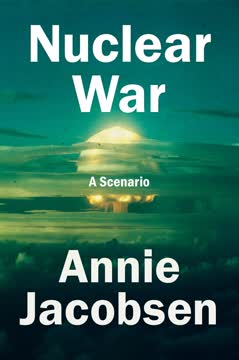Key Takeaways
1. Boeing's transformation from engineering excellence to shareholder primacy
"When people say I changed the culture of Boeing, that was the intent, so that it's run like a business rather than a great engineering firm."
From engineers to financiers. Boeing, once a beacon of engineering excellence, underwent a dramatic transformation in the late 20th and early 21st centuries. The company shifted from a culture that prioritized innovation and quality to one focused on financial metrics and shareholder returns. This change was driven by:
- Adoption of GE-style management practices
- Increased focus on stock price and financial performance
- Pressure to compete with Airbus and maintain market dominance
Consequences of the shift. The transformation had far-reaching effects on Boeing's operations and products:
- Reduced investment in research and development
- Increased outsourcing of manufacturing and design
- Emphasis on cost-cutting over engineering excellence
- Strained relationships with labor unions and longtime employees
2. The McDonnell Douglas merger: A cultural clash that reshaped Boeing
"McDonnell Douglas has bought Boeing with Boeing's money."
A merger of unequals. The 1997 merger between Boeing and McDonnell Douglas was a pivotal moment in Boeing's history. Despite Boeing being the acquirer, the merger resulted in McDonnell Douglas executives gaining significant influence over the combined company's direction.
Cultural transformation. The merger brought about significant changes:
- Introduction of a more aggressive, finance-driven management style
- Shift away from Boeing's traditional engineering-centric culture
- Increased focus on military contracts and diversification
- Adoption of McDonnell Douglas's cost-cutting approaches
Long-term impact. The cultural clash resulting from the merger had lasting effects on Boeing:
- Erosion of the company's reputation for engineering excellence
- Increased internal tensions between legacy Boeing employees and new management
- Set the stage for future decisions prioritizing financial performance over product quality
3. The 737 MAX: A flawed design born from cost-cutting and market pressures
"Stingy with a purpose."
Market pressures. Boeing's decision to update the 737 rather than design a new aircraft was driven by:
- Competitive pressure from Airbus's A320neo
- Desire to avoid costly pilot retraining for airlines
- Need for a quick solution to maintain market share
Design compromises. The 737 MAX's development was characterized by:
- Retrofitting larger engines onto an aging airframe
- Introduction of the MCAS system to compensate for changed flight characteristics
- Minimal changes to avoid triggering additional regulatory scrutiny
Consequences of rushed development:
- Inadequate testing and validation of new systems
- Insufficient pilot training and documentation
- Ultimately, two fatal crashes and a global grounding of the aircraft
4. FAA's declining oversight: From regulator to Boeing's partner
"We used to measure success by how high our stack of hate mail was. That's no longer the case."
Regulatory capture. Over time, the FAA's relationship with Boeing shifted from oversight to partnership:
- Increased delegation of certification responsibilities to Boeing
- Pressure to streamline approvals and reduce "red tape"
- Revolving door between FAA leadership and industry positions
Systemic failures. The FAA's declining oversight contributed to the 737 MAX crisis:
- Insufficient scrutiny of MCAS and other critical systems
- Approval of reduced pilot training requirements
- Delayed grounding of the 737 MAX after initial crash
Consequences:
- Loss of public trust in the FAA's ability to ensure aviation safety
- Calls for reform and increased independence of regulators
- Damaged reputation of U.S. aviation safety globally
5. MCAS: The fatal flaw that brought down two planes
"We can't lose Boeing."
A flawed solution. The Maneuvering Characteristics Augmentation System (MCAS) was introduced to address aerodynamic changes in the 737 MAX:
- Designed to activate based on a single angle-of-attack sensor
- Could repeatedly push the nose down, even against pilot inputs
- Poorly documented and not included in pilot training materials
Fatal consequences. MCAS played a central role in two crashes:
- Lion Air Flight 610 (October 2018): 189 fatalities
- Ethiopian Airlines Flight 302 (March 2019): 157 fatalities
Systemic failures. The MCAS saga revealed deeper issues within Boeing and the FAA:
- Pressure to minimize design changes and avoid additional pilot training
- Insufficient consideration of human factors and potential failure modes
- Inadequate oversight and testing of critical safety systems
6. Corporate culture: Prioritizing profits over safety and quality
"Ideas are measured in dollars."
Shift in priorities. Boeing's culture underwent a dramatic transformation:
- From engineering-driven to finance-driven decision-making
- Emphasis on cost-cutting and efficiency over innovation and quality
- Pressure to meet delivery deadlines and financial targets
Consequences of cultural change:
- Reduced emphasis on safety and engineering excellence
- Strained relationships with employees and unions
- Increased outsourcing and fragmentation of the supply chain
Warning signs ignored. Multiple red flags were dismissed or downplayed:
- Employee concerns about safety and quality issues
- Pressure on engineers to cut corners and reduce costs
- Insufficient attention to potential failure modes and safety risks
7. The human cost: 346 lives lost and a legacy tarnished
"I want to hear my kids talk to me."
Lives shattered. The 737 MAX crashes had devastating human consequences:
- 346 people from diverse backgrounds and nationalities lost
- Families and communities left grieving and seeking answers
- Pilots and crew members put in impossible situations
Beyond statistics. The book humanizes the victims and their families:
- Personal stories of those lost in the crashes
- Ongoing struggles of surviving family members
- Impact on communities and the aviation industry as a whole
A tarnished legacy. Boeing's reputation suffered immense damage:
- Loss of trust from airlines, pilots, and the flying public
- Billions in financial losses and compensation payments
- Long-term impact on Boeing's market position and future prospects
8. Accountability: Boeing's response to the crisis and legal consequences
"Boeing got away with murder."
Initial response. Boeing's handling of the crisis was widely criticized:
- Slow to acknowledge responsibility for the crashes
- Attempts to shift blame to pilots and airlines
- Reluctance to ground the 737 MAX despite mounting evidence
Legal and financial consequences:
- $2.5 billion settlement with the U.S. Department of Justice
- Billions in compensation to airlines and victims' families
- Civil lawsuits and ongoing legal challenges
Cultural reckoning? Questions remain about long-term change at Boeing:
- Leadership changes, including the ouster of CEO Dennis Muilenburg
- Promises of renewed focus on safety and engineering excellence
- Skepticism about the depth and sustainability of cultural reforms
This is the essence of "Flying Blind" by Peter Robison, capturing the key takeaways and most impactful aspects of Boeing's 737 MAX crisis and its underlying causes.
Last updated:
FAQ
What's Flying Blind: The 737 MAX Tragedy and the Fall of Boeing about?
- Focus on Crashes: The book examines the tragic crashes of the Boeing 737 MAX, exploring the design flaws and corporate culture that contributed to these disasters.
- Corporate Culture Shift: It critiques Boeing's transition from an engineering-driven company to one focused on shareholder value, impacting safety and accountability.
- Human Element: Personal stories of victims and their families are woven into the narrative, adding depth to the technical and corporate discussions.
Why should I read Flying Blind by Peter Robison?
- Aviation Safety Insight: Offers a detailed look at the balance between safety and profit in the aviation industry, essential for those interested in aviation or corporate ethics.
- Corporate Governance Lessons: Highlights the consequences of prioritizing profits over safety, providing relevant lessons for all industries.
- Engaging Storytelling: Combines investigative journalism with storytelling, making complex topics accessible and engaging.
What are the key takeaways of Flying Blind?
- Safety Culture Importance: Emphasizes the necessity of a strong safety culture in industries where lives are at stake, warning against neglecting this aspect.
- Outsourcing Oversight Risks: Discusses how delegating safety oversight to manufacturers can create conflicts of interest and reduce accountability.
- Corporate Decision Impact: Illustrates how decisions driven by financial metrics can have dire consequences for employees and customers.
What are the best quotes from Flying Blind and what do they mean?
- “The ghost won.”: Highlights the tension between human operators and automated systems, as seen when the 737 MAX's systems overpowered pilot control.
- “This airplane is designed by clowns, who in turn are supervised by monkeys.”: Reflects employee frustration with management decisions that compromised safety.
- “Everybody thinks they’re different.”: Critiques the complacency within Boeing and the FAA, serving as a cautionary reminder of overconfidence.
What led to the crashes of the 737 MAX according to Flying Blind?
- MCAS Software Issues: The Maneuvering Characteristics Augmentation System malfunctioned due to faulty sensor data, leading to the crashes.
- Pilot Training Gaps: Inadequate training on the new software contributed to pilots' inability to regain control during emergencies.
- Regulatory Failures: The FAA's reliance on Boeing for safety oversight allowed critical flaws to go unchecked, compromising aircraft safety.
How did Boeing's corporate culture change over time as described in Flying Blind?
- Shift to Shareholder Value: Transitioned from an engineering-focused company to one prioritizing shareholder returns, leading to cost-cutting measures.
- Management Practices: Rewarded financial performance over engineering excellence, favoring profits at the expense of safety.
- Impact on Employees: Created an environment where employees felt pressured to conform to financial goals, compromising professional integrity.
What role did the FAA play in the 737 MAX crisis according to Flying Blind?
- Regulatory Capture: The FAA's close relationship with Boeing led to a lack of rigorous oversight, allowing the company to self-certify aspects of the MAX.
- Delegation of Authority: Allowed Boeing to appoint its own safety representatives, diluting the agency's authority and oversight capabilities.
- Failure to Act: Despite warnings, the FAA was slow to respond to safety concerns, contributing to the tragic outcomes.
How did the crashes affect Boeing's reputation as discussed in Flying Blind?
- Loss of Trust: Severely damaged public trust in Boeing, shifting its perception from a symbol of American ingenuity to one of corporate negligence.
- Financial Consequences: Grounding of the 737 MAX and investigations cost Boeing billions, impacting its stock price and market position.
- Cultural Reflection: Prompted discussions about corporate ethics and accountability, leading to calls for regulatory reforms.
What is the MCAS system discussed in Flying Blind?
- Purpose of MCAS: Designed to enhance handling characteristics of the 737 MAX, particularly during high-speed maneuvers, by preventing stalls.
- Design Flaw: Relied on data from a single sensor, creating a critical vulnerability that could lead to loss of control.
- Consequences: The flawed design contributed to two fatal crashes, highlighting the importance of redundancy in safety systems.
How did Boeing's management respond to the crises according to Flying Blind?
- Leadership Changes: Underwent significant leadership changes, including the ousting of CEO Dennis Muilenburg, to restore confidence.
- Crisis Management Strategies: Implemented public relations campaigns and safety reviews, though often criticized as insufficient.
- Focus on Safety Culture: Renewed emphasis on rebuilding safety culture, with promises to prioritize engineering excellence and accountability.
What changes were made to the 737 MAX after the crashes as per Flying Blind?
- Software Updates: Implemented changes to the MCAS software, including using data from two sensors to prevent erroneous activations.
- Pilot Training Requirements: FAA mandated simulator training for the MAX, reflecting a commitment to improving pilot preparedness.
- Regulatory Reforms: Legislative efforts aimed to reform FAA's oversight practices, enhancing safety and preventing similar incidents.
What does Flying Blind say about the future of Boeing?
- Challenges Ahead: Faces significant challenges in restoring its reputation and ensuring aircraft safety, with lasting scars from the MAX crisis.
- Cultural Shift Needed: Emphasizes the need for a cultural shift prioritizing safety and ethical decision-making over profits.
- Long-Term Impact: Indicates that the MAX crisis will have long-term implications for Boeing's business model and operational practices.
Review Summary
Flying Blind by Peter Robison explores Boeing's transformation from a safety-focused engineering company to one driven by profits and cost-cutting, culminating in the 737 MAX crashes. Readers praise Robison's thorough research and engaging writing style, finding the book both informative and infuriating. Many commend its exposure of corporate greed and regulatory failures. Some criticize the book's political bias and excessive detail on peripheral characters. Overall, reviewers appreciate the comprehensive look at Boeing's history and the events leading to the tragic crashes, recommending it as an important read on corporate culture and aviation safety.
Similar Books








Download PDF
Download EPUB
.epub digital book format is ideal for reading ebooks on phones, tablets, and e-readers.




